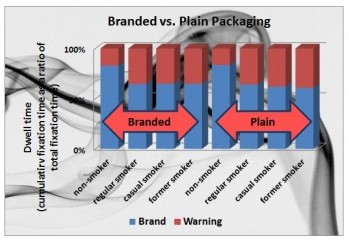Standardised packaging
Plain packaging is intended, according the the anti-smoking proponents, to reduce the number of people (some claims state 'children,' instead of people) taking up smoking because it will "make them less attractive."
Others have pointed out that plain packaging lowers the existing barriers to counterfeiting by allowing the counterfeiters to not bother too hard with one aspect of making fake cigarrettes.
J Padilla & N Watson (2008)
Commissioned for Phillip Morris International (PMI), by The Law and Economics Consulting Group(LECG) to review previous research on the subject of generic (plain) packaging, largely with regard to teenagers. It concludes that none of those papers reviewed could provide a reliable basis on which to determine if plain packaging would reduce smoking levels.
M Goldberg, et al. (1995)
A report for Health Canada, of teenagers, over 5 different studies, to examine the potential effect plain packaging might have on
- the uptake of smoking to begin with,
- the impact on the recognition of, and the ability to remember, the warnings on packaging,
- the probability of stopping smoking
The surveys were largely about what teenagers think they'd do, and not what they'd actually do, with regard to plain packaging.
Department of Health (2008)
Entitled Consultation on the future of tobacco control, aimed at "PCT CEs, NHS Trust CEs, SHA CEs, Foundation Trust CEs, Medical Directors, Directors of PH, Directors of Nursing, Local Authority CEs, Communications Leads," this report came up with a lot of conclusions that contained the words 'may,' 'might,' 'could' and other weasel words.
It was also very selective in quoting parts of other research, while ignoring the parts that contradicted the, perceived, desired outcome for this report.
Munafò, Roberts, Bauld & Leonards (2011)
A study of the eye movements of 43 (either largely or solely) university-age students when presented with images of both branded and plain packs.
Problems with the study include disparity in the size of packs used between branded and plain packs, and the small number of participants (less than 25 in each of the three cohorts) with a total male/female ratio of 2/1 and what is presumed to be a narrow age range (average age was 23/24.)
Royal Holloway, University of London project
While nothing as grand as a 'study' with a published paper such as the University of Bristol study appears to pretend to be, Tim Holmes has been supervising a study by his 3rd year psychology students[1]. In his own words:
- We invited 59 non-smokers, regular smokers, social smokers (the ones who maybe smoke just on a Friday evening after a couple of drinks) and ex-smokers (who have given up for at least 6 months) to look at examples of 4 different package designs including regular branding, 2 types of picture warning labels and plain packaging. We tracked the participants’ eye-movements using a Tobii X120 eye-tracker, and showed each design with 4 different warning messages for 10 seconds each. We also asked participants to evaluate the risks associated with smoking before and after viewing the 16 packages. Unsurprisingly non-smokers tended to perceive a greater risk from smoking than the other 3 groups and disappointingly there was no change in risk perception as a result of viewing the stimuli.
- To be honest, our initial hypotheses all related to the picture messages and in the best research tradition returned non-significant results! However, we were surprised to observe two interesting results: the non-smokers looked at the warning messages much less than the other participants, and there was no difference between plain and branded package designs in the amount of time spent looking at the warning message. Now, it’s great that the right people are looking more at the warning message, but if this doesn’t result in an increased risk perception then surely the messages aren’t doing their job! Moreover, if removing the brand identity doesn’t change the way people look at the packets then maybe plain packaging, which will be costly to implement, isn’t the best of ideas.
